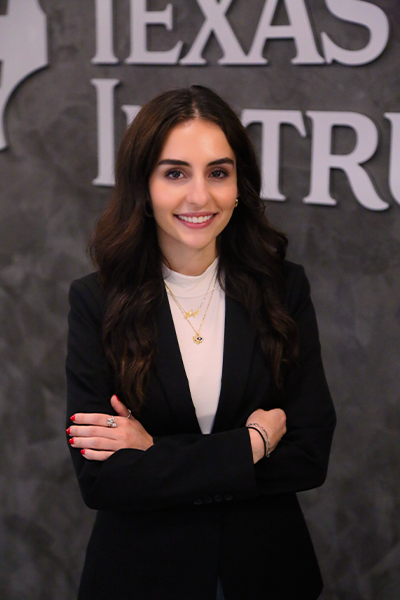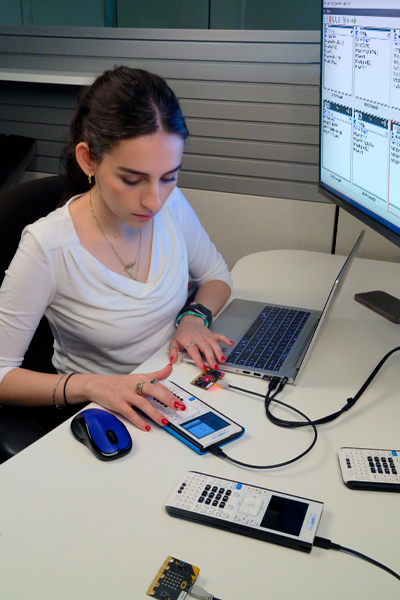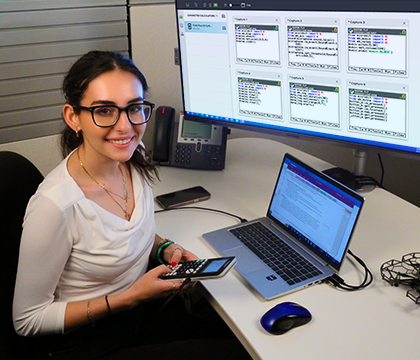Women Who Code: A TI Intern’s Fascinating STEM Journey
Imagine sliding into the desk of your first engineering class as a freshman in college. You look around the room and realize, that out of the 200 or so students, you are one of only 20 women in the class. Fast forward three years, and now you’re a computer engineering major working as an intern for TI’s Education Technology group. That’s where Megi Shahollari now finds herself. But, her STEM journey began way before this.

Overcoming barriers
As a third grader, Shahollari moved from Albania to the U.S. with her parents and younger brother after her family won a visa lottery. While her parents had stable jobs in that developing country, the lack of opportunities for their children was the deciding factor to move. Shahollari said it was a “a big sacrifice” for her father, especially due to his high standing in the Albanian military. “In the long run, he just did it for me and my brother. The primary goal was to get a good education so we can find a job.”
Shahollari didn’t know any English before coming to the states, and she remembered being “just thrown in” to a regular school. The only language help she received was through an ESL tutor for one hour a week. One of the first phrases Shahollari learned in school, she vividly recalled, was of a fellow student calling her out on her numbers. “It was probably my second day in school, and I didn’t understand anything. But we were doing math, and a nine in Europe, you kind of write it like a G. That’s just how we do it. And this girl next to me says, ‘Not a G, a nine!’ It’s the first English phrase that ever stuck with me,” she laughed at the memory. Math, on the other hand, was something she was very comfortable with.
Like many children, Shahollari thought of becoming a doctor when she grew up. She wanted to make her parents proud and work toward a goal that seemed worthy of the sacrifice they had made. However, the more classes she took through high school and college, she thought that maybe being a doctor wasn’t for her. “My parents encouraged me — like a lot — just to kind of do what I wanted to do,” she related. Knowing that she’d always been good at math, talking to her teachers made her realize that engineering might be the path she needed to follow, specifically either biomedical or chemical engineering, because she felt those fields tend to have more women in them.
In her freshman year, she had to take Engineering 101. “That’s when I got exposed to coding,” she paused and then laughed. “I did not even know what coding was. I thought it was used only for hacking because that is what was presented in the movies. I had no idea you can use code for truly anything!”
“I thought [coding] was used only for hacking because that is what was presented in the movies.”
But even though Shahollari was surrounded by fellow students who had a similar love of math, she admitted, “I didn’t necessarily feel welcome then. There were probably like, 200 of us, and only like 20 girls.” She was intimidated by her classmates, thinking “they are so much smarter than me.” Especially because they were grasping onto topics easier than she was, as many of them were international students who had been coding since their first year of high school (or even before that).
Even today, as she is about to begin her senior year at the University of Michigan, Shahollari finds herself surrounded by fewer and fewer women in her major. She matter-of-factly stated that, “a lot of girls end up dropping out of engineering.” This has sometimes hindered projects in her higher-level engineering classes. “It’s very frustrating, because when we’re working in groups, the guys don’t let you do anything. They’re like, ‘it’s okay … I got it.’ So, I feel like guys have this thought that a girl can’t do what they do, which I think is very frustrating.” But, she acknowledged that, “as the semester progresses, and classmates start getting closer, the guys do start to respect you.” And, she mentioned that, thankfully, her teachers have always been helpful toward her and other women in the field.
Learning to think like a computer
In her first year of college, many of the programs Shahollari was assigned were simple mathematical formulas, never longer than 10 lines. They were simple so students could get exposed to a calculator for everyday use. “The hardest part of coding is training your mind to think like a computer,” she emphasized. “You have to train yourself to think logically about each process.” Because she hadn’t been exposed to coding earlier in her life, and this process wasn’t something she had been taught in college, Shahollari struggled in her first-year engineering courses. But, at the same time, she said, “I loved the challenges. They were so rewarding. In that class, I realized that no other major will give me this type of satisfaction.”
“The hardest part of coding is training your mind to think like a computer.”
When it was time to declare a major, Shahollari had initially decided on chemical engineering because she also really enjoyed chemistry. However, “My parents knew that I was into coding, but I almost didn’t even pick it because the classes are very intimidating. They said, ‘It doesn’t really matter in the long run. Do you want to do something you truly enjoy or something that’s going to be hard in the moment, but like, in five years, won't really matter?’” So, she ended up declaring computer engineering as her major.
Shahollari gave a few reasons as to why she fell in love with coding:
- Being able to calculate many data points at once.
- The ability to use your own code to double-check your own work. For example, she said, “When solving complicated math equations, students will type in every step in the calculator … to check their work. But you can also code it in four to five lines to get the same answer.” With this tip, Shahollari has learned to check her work with a quick program.
- The ability to create anything, and that you are in control of the outcome. In her sophomore year, Shahollari had to develop a user interactive game. It was her first time adding visuals to her code. But she was in control of every aspect of the game, and so she was able to see how changing one line of code could affect the game. She said that this “was the first turning point for me” as she could see how coding brought something to life.
The value of coding on a calculator
Like many high school students in the U.S., Shahollari used a TI graphing calculator in her math classes. But, she never used the handheld for coding, nor did she know it could also be used for that. As she’s been working with the TI STEM Team on some exciting top-secret projects, she’s seen how they are working hard to help teachers expose students to coding and the benefits that can provide.

Shahollari shared a few reasons as to why she feels learning to code on a calculator is beneficial:
- It teaches you to think like a computer. “Honestly, that’s the hardest part.” She noted that her university coding classes only focus on syntax and not logical thinking, which supports the structure of a program. So, logical thinking was hard for her to learn. “That’s why the calculator is so great! Early exposure to coding on a calculator helps your brain get trained on logical thinking. The calculator makes it easy with syntax — a lot is provided for you.”
- The ability to learn without a computer. “Most high school students don’t have computers,” she acknowledged. If they don’t have a computer, then they don’t have access to an integrated development environment (IDE) — a software application that helps programmers develop software code efficiently. A handheld can be taken anywhere.
- You start coding on a product you’re already familiar with. “Everyone has a TI calculator!” she exclaimed.
- You notice how much creativity goes into coding. Shahollari thought that the term “creative” was associated with being artistic. However, she learned that one can be creative in their code. “You can code the same program multiple different ways and still get the same product at the end.” As she’s learned more, this has also increased the efficiency of her code and allowed her to manipulate it to be more sophisticated.
“That’s why the calculator is so great! Early exposure to coding on a calculator helps your brain get trained on logical thinking.”
Looking toward the future
When thinking about what advice she would give STEM teachers to help their students, Shahollari directly stated, “I think they need to start incorporating coding more.” She proposed that using a Python-enabled calculator is ideal, but acknowledged that budget constraints could prevent teachers from upgrading. However, she said, “Using a calculator is the easiest thing they can do because they already use the calculator every day.” Her recommendation: Start doing simple math programs, especially on a graphing calculator. “I think that early exposure is everything.”
As far as advice for middle and high school girls who might not think coding is for them, Shahollari mentioned checking out YouTube for simple tutorials to help them get started, or at least as a way to get exposed to coding. “A lot of people, especially girls, have the wrong idea of coding and they’re intimidated to try it out. I’d also focus on math because there’s a lot of math in coding.” Ultimately, she said, “Just try it out!”
Shahollari expressed choosing a major and a career to pursue for the rest of your life can be intimidating. “In today’s day and age, with everything going toward technology … high schools are not really supporting that. Even with my internship, I’ve seen that you need coding. It’s crazy to think that I only got exposure to it three years ago.” She mentioned that even if a degree sounds terrifying — whether it be electrical, computer or chemical engineering, or something else — it’s going to be difficult. But, she pointed out, “You learn so much that, in the end, you’re able to do what they teach you in class. Nothing beats that feeling!” She paused, then smiled. “You feel like you can do this, and your hard work is paying off.”

“I want to make technology easy for anyone to use.”
As her internship winds down and she prepares for her senior year, Shahollari is looking forward to rounding out her degree with fun (for her) classes as well as adding a minor in math, as she only needs a few more credits in that area. After she graduates, she expressed that she wants to “develop programs that provide a better user experience, whether that’s in testing or just overall designing websites. I want to make technology easy for anyone to use.”
About Megi Shahollari: Shahollari is a summer 2023 intern for the Education Technology group at Texas Instruments. She will be a senior at the University of Michigan in the fall of 2023, majoring in computer engineering, with a minor in math. She hopes to be able to work on systems (specifically software) that can improve the lives of others. In her free time, she enjoys shopping — especially when she can make a day of it.
